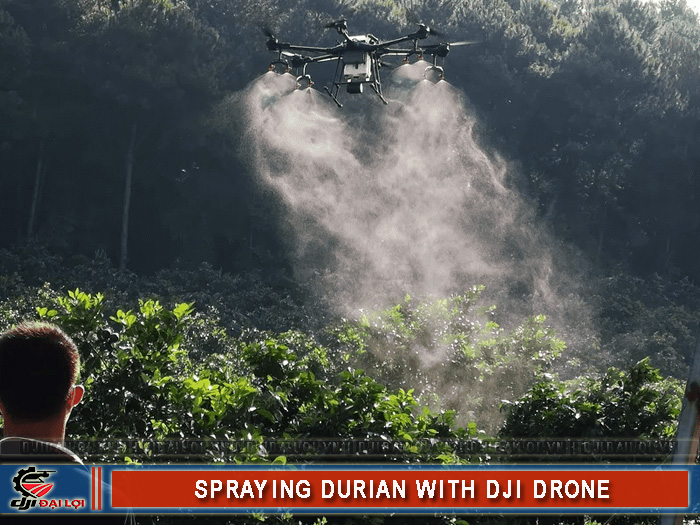
In many durian orchards - especially in the Central Highlands and Southeast Vietnam - farmers face three key challenges:
Therefore, using DJI durian-spraying drones has become a technological step forward, helping reduce labor, increase efficiency, and achieve even canopy coverage.
For example, in Thailand, a durian grower using a DJI drone to spray a 14-hectare orchard reported completing the job in just 1–2 days instead of four with manual spraying.
This leads to the key question: is drone spraying for durians truly effective, and is it worth the investment?
To properly assess the efficiency of durian-spraying drones, several technical and operational factors should be considered:
Durian trees often grow 6–10 meters tall with wide, multi-layered canopies. The drone must fly at adjustable heights and deliver fine, penetrating spray droplets. Studies show that upper canopy coverage is often higher than the middle or lower layers, which remain harder to reach.
Droplets must be fine enough to adhere and absorb effectively. DJI’s data indicates that drone spraying can reduce chemical use by 20–30% compared to manual methods. Optimizing the nozzles, spray pressure, and flight path is key to achieving both efficiency and cost savings.
Compared to manual sprayers, drones can cover large orchards quickly. For instance, in Vietnam’s sloped durian–coffee farms, a DJI T30 completed 9.9 hectares in 2.5 days, whereas manual spraying required over 10 days - a significant improvement during the rainy season when time is critical.
Durian orchards are rarely flat. Many include slopes, mixed crops, and uneven terrain. A durian-spraying drone equipped with obstacle sensors and automated flight mapping can navigate safely - something ground-based methods struggle with.
→ When properly operated, durian-spraying drones offer major advantages, but they are not a “one-size-fits-all” solution and should be applied under the right conditions.
At a durian farm in Chumphon Province, the DJI AGRAS T30 achieved up to 98% pest control on 7–8 m tall trees using a spray height of ~3 m and a flight speed of 1.2 m/s. The drone completed 40 rai per day, while manual spraying covered only 5 rai - an 8× efficiency gain.
In Binh Thuan, where durians and coffee are intercropped on hilly land, the DJI AGRAS T30 sprayed 9.9 hectares in 2.5 days, using 120 L/ha at a speed of ~1.6 m/s - saving significant labor and time compared to manual methods.
DJI’s Agricultural Drone Industry Insight Report shows drone use can reduce operational costs by ~50% and pesticide use by ~51% across various crops. While not durian-specific, the data reinforces the positive potential of this technology.
→ Overall, the results demonstrate that durian-spraying drones deliver excellent performance when operated under suitable conditions.
|
Criteria |
Manual Spraying (Backpack or Ground) |
Durian-Spraying Drone |
|---|---|---|
|
Daily area coverage |
~5 rai/day |
~40 rai/day (DJI T30) |
|
Upper canopy coverage |
Hard to reach |
Even and adjustable |
|
Chemical usage |
High, with waste |
20–30% lower |
|
Labor demand & safety risk |
High exposure to chemicals |
Low exposure, safer |
|
Initial investment |
Low |
High (equipment & training) |
|
Terrain adaptability |
Poor (slope, obstacles) |
Excellent (flexible flight) |
|
Technical requirements |
Minimal |
Requires trained pilot & mapping skills |
Using DJI durian-spraying drones has proven highly effective across multiple case studies - increasing spraying speed, improving canopy coverage, reducing chemical use, and cutting labor costs. However, the best results are achieved when farms meet key conditions: large areas, tall trees, trained operators, and proper workflows. For smaller farms or limited budgets, traditional spraying methods remain a reasonable alternative.
Yes, if equipped with navigation lights and night-vision sensors. However, spraying should only be done in stable weather and without fog.
Yes. In many regions, unmanned aircraft must be registered, especially when operating over large areas or near residential zones.
Yes. Multifunctional models like DJI T20P or T40 can be fitted with spreading modules for granular fertilizer or foliar feeding.
No, provided spraying avoids peak flowering stages. Spraying during full bloom should be avoided to prevent pollination disturbance.
Yes. Avoid powder-based or coarse-grained formulations, as they may clog nozzles. Use liquid or micro-emulsion types compatible with centrifugal sprayers.